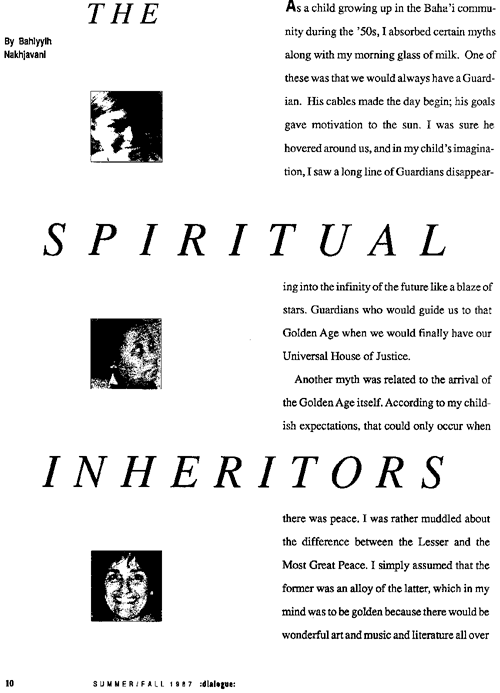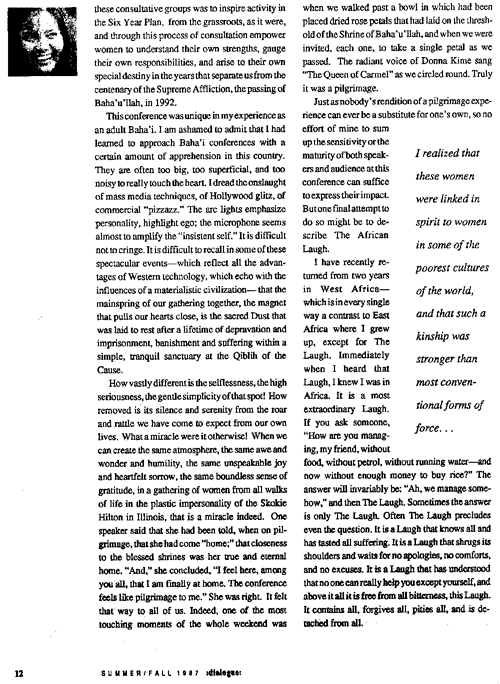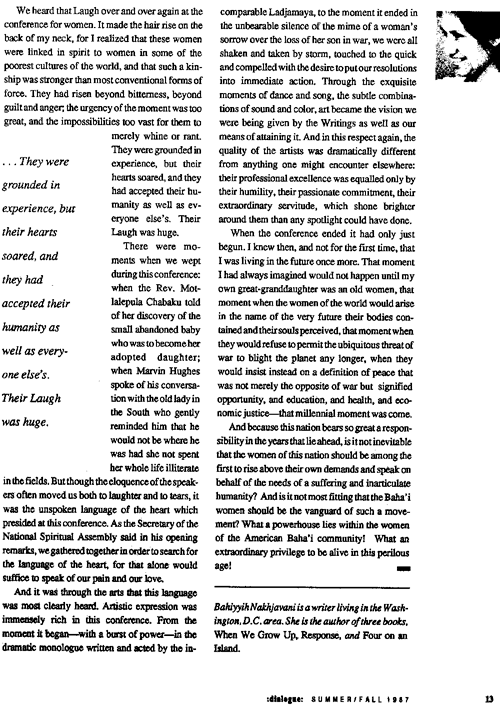
|
|
Abstract: Reflections on growing up Bahá'í, and a report on a conference about capturing the power of the Six Year Plan to focus attention on the role of women in establishing global peace, the destiny of the women of North America, and equality of sexes. Notes: See also list of dialogue articles or image scans. |
The Spiritual Inheritors
by Bahiyyih Nakhjavani
published in dialogue, 2:1, pages 10-13Los Angeles: 1987
Another myth was related to the arrival of the Golden Age itself. According to my childish expectations, that could only occur when there was peace. I was rather muddled about the difference between the Lesser and the Most Great Peace. I simply assumed that the former was an alloy of the latter, which in my mind was to be golden because there would be wonderful art and music and literature all over the place. I looked forward to the kind of global thunderclap that would bring these goodies into our lives, some 800 years hence.
Finally, there was a myth about women. It seemed, according to 'Abdu'l-Bahá, that the business of peace was intricately linked to the equality of the sexes, although the reason for this remained a pleasant mystery to me. Since the former shimmered like the Holy Grail down the tunnel of centuries, so did the latter. Women, I decided furiously — as my mother insisted in brushing the tangles out of my hair — needed the whole of this dispensation to prepare themselves to be more than just a pretty face.
The first myth was shattered with the passing of Shoghi Effendi. Not only was he not immortal, but he chose not to appoint another Guardian to replace him. Instead, he left the Bahá'í world with a detailed plan, a crusade that chartered our path to the eve of the centenary of the declaration of the Blessed Beauty in 1963. And at this point — which happened to coincide with my fifteenth birthday — a miracle occurred. The Universal House of Justice, that I had expected to anticipate all my life, came into being and stood before my eyes. In London, at the conference of the Most Great Jubilee, I saw the dream become a reality, the vision of the future become proof of the present moment. I felt I was living ahead of myself.
The second myth was exploded when the Universal House of Justice sent us the Promise of World Peace Message in October 1985. Their letter, addressed “To the Peoples of the World,” made me realize that the “Lesser Peace” I had assumed was several centuries away was indeed imminent, and would necessarily be initiated before the close of this century as foretold by 'Abdu'l-Bahá, and was a process, both arduous and daunting, that would begin the painful birth of a new world civilization. Instead of dreaming about peace, we were being challenged to construct it, cell by cell, organically. Instead of imagining it as a goal, we were being summoned to perceive it as a means to attain the Golden Age. Again, I had the curious sensation that I was alive ahead of myself.
And finally, the last myth shivered into a thousand particles before my eyes during the weekend of February 20-22, 1987, in Wilmette, at a conference intended to inspire the extraordinary powers inherent in the Six Year Plan, which the Universal House of Justice termed the beginning of a “new epoch” in the history of the Faith. Invited by the National Committee on Women, 270 representatives from Bahá'í communities all over the country gathered together, with the blessing of the National Spiritual Assembly, to focus their attention, at last, on the role and destiny of women in the establishment of peace in the world; on the link, emphasized by 'Abdu'l-Bahá’s promises, between the equality of sexes and the strengthening of peace; and on the particular destiny of the Bahá'í women of North America — whether young or old, black or white, mothers — in taking up the spiritual challenge given to us to work as reconcilers, peace-weavers, bridge-builders, bond-forgers within the communities and among people in all walks of life.
We were given a vision that coincided with the vision of Tahirih, and were asked to respond to that challenge with the forbearance, patience, and servitude of the Greatest Holy Leaf. We discovered ourselves to be the spiritual inheritors of the disciples of 'Abdu'l-Bahá, and we were provided with tools to achieve His aims no less miraculous than those bequeathed to us by Bahá'u'lláh: unity and consultation. We were encouraged to leave the conference and help create consultative groups in localities all over the country, groups where Bahá'í and non-Bahá'í women (initially) could gather in an atmosphere of trust and consult on practical issues that affect us all, on problems that have to be faced on a daily basis. Through these groups, women would find themselves galvanized to rise and meet the challenge of the Peace Message. They would be a forum for the social and economic development of women and a place where they could begin to transform ideals into practical expression and action. They would not be exclusive or create hostility towards men; they were not intended for group therapy or gossip. They were sanctioned by the National Spiritual Assembly and needed the encouragement of the Local Spiritual Assemblies and should in no way be perceived as an administrative threat. The whole purpose of these consultative groups was to inspire activity in the Six Year Plan, from the grassroots, as it were, and through this process of consultation empower women to understand their own strengths, gauge their own responsibilities, and arise to their own special destiny in the years that separate us from the centenary of the Supreme Affliction, the passing of Bahá'u'lláh, in 1992.
This conference was unique in my experience as an adult Bahá'í. I am ashamed to admit that I had learned to approach Bahá'í conferences with a certain amount of apprehension in this country. They are often too big, too superficial, and too noisy to really touch the heart. I dread the onslaught of mass media techniques, of Hollywood glitz, of commercial “pizzazz.” The arc lights emphasize personality, highlight ego; the microphone seems almost to amplify the “insistent self.” It is difficult not to cringe. It is difficult to recall in some of these spectacular events — which reflect all the advantages of Western technology, which echo with the influences of a materialistic civilization — that the mainspring of our gathering together, the magnet that pulls our hearts close, is the sacred Dust that was laid to rest after a lifetime of depravation and imprisonment, banishment and suffering within a simple, tranquil sanctuary at the Qiblih of the Cause.
How vastly different is the selflessness, the high seriousness, the gentle simplicity of that spot! How removed is its silence and serenity from the roar and rattle we have come to expect from our own lives. What a miracle were it otherwise! When we can create the same atmosphere, the same awe and wonder and humility, the same unspeakable joy and heartfelt sorrow, the same boundless sense of gratitude, in a gathering of women from all walks of life in the plastic impersonality of the Skokie Hilton in Illinois, that is a miracle indeed. One speaker said that she had been told, when on pilgrimage, that she had come “home;” that closeness to the blessed shrines was her true and eternal home. “And,” she concluded, “I feel here, among you all, that I am finally at home. The conference feels like pilgrimage to me.” She was right. It felt that way to all of us. Indeed, one of the most touching moments of the whole weekend was when we walked past a bowl in which had been placed dried rose petals that had laid on the threshold of the Shrine of Bahá'u'lláh, and when we were invited, each one, to take a single petal as we passed. The radiant voice of Donna Kime sang “The Queen of Carmel” as we circled round. Truly it was a pilgrimage.
Just as nobody’s rendition of a pilgrimage experience can ever be a substitute for one’s own, so no effort of mine to sum up the sensitivity or the maturity of both speakers and audience at this conference can suffice to express their impact. But one final attempt to do so might be to describe The African Laugh.
I have recently returned from two years in West Africa — which is in every single way a contrast to East Africa where I grew up, except for The Laugh. Immediately when I heard that Laugh, I knew I was in Africa. It is a most extraordinary Laugh. If you ask someone, “How are you managing, my friend, without food, without petrol, without running water — and now without enough money to buy rice?” The answer will invariably be: “Ah, we manage somehow,” and then The Laugh. Sometimes the answer is only The Laugh. Often The Laugh precludes even the question. It is a Laugh that shrugs its shoulders and waits for no apologies, no comforts, and no excuses. It is a Laugh that has understood that no one can really help you except yourself, and above all it is free from all bitterness, this Laugh. It contains all, forgives all, pities all, and is detached from all.
We heard that Laugh over and over again at the conference for women. It made the hair rise on the back of my neck, for I realized that these women were linked in spirit to women in some of the poorest cultures of the world, and that such a kinship was stronger than most conventional forms of force. They had risen beyond bitterness, beyond guilt and anger; the urgency of the moment was too great, and the impossibilities too vast for them to merely whine or rant. They were grounded in experience, but their hearts soared, and they had accepted their humanity as well as everyone else’s. Their Laugh was huge.
There were moments when we wept during this conference: when the Rev. Motlalepula Chabaku told of her discovery of the small abandoned baby who was to become her adopted daughter; when Marvin Hughes spoke of his conversation with the old lady in the South who gently reminded him that he would not be where he was had she not spent her whole life illiterate in the fields. But though the eloquence of the speakers often moved us both to laughter and to tears, it was the unspoken language of the heart which presided at this conference. As the Secretary of the National Spiritual Assembly said in his opening remarks, we gathered together in order to search for the language of the heart, for that alone would suffice to speak of our pain and our love.
And it was through the arts that this language was most clearly heard. Artistic expression was immensely rich in this conference. From the moment it began — with a burst of power — in the dramatic monologue written and acted by the incomparable Ladjamaya, to the moment it ended in the unbearable silence of the mime of a woman’s sorrow over the loss of her son in war, we were all shaken and taken by storm, touched to the quick and compelled with the desire to put our resolutions into immediate action. Through the exquisite moments of dance and song, the subtle combinations of sound and color, art became the vision we were being given by the Writings as well as our means of attaining it. And in this respect again, the quality of the artists was dramatically different from anything one might encounter elsewhere: their professional excellence was equalled only by their humility, their passionate commitment, their extraordinary servitude, which shone brighter around them than any spotlight could have done.
When the conference ended it had only just begun. I knew then, and not for the first time, that I was living in the future once more. That moment I had always imagined would not happen until my own great-granddaughter was an old women, that moment when the women of the world would arise in the name of the very future their bodies contained and their souls perceived, that moment when they would refuse to permit the ubiquitous threat of war to blight the planet any longer, when they would insist instead on a definition of peace that was not merely the opposite of war but signified opportunity, and education, and health, and economic justice — that millennial moment was come.
And because this nation bears so great a responsibility in the years that lie ahead, is it not inevitable that the women of this nation should be among the first to rise above their own demands and speak on behalf of the needs of a suffering and inarticulate humanity? And is it not most fitting that the Bahá'í women should be the vanguard of such a movement? What a powerhouse lies within the women of the American Bahá'í community! What an extraordinary privilege to be alive in this perilous age!
Bahiyyih Nakhjavani is a writer living in the Washington, D.C. area. She is the author of three books, When We Grow Up, Response, and Four on an Island.
 click for larger image |
 click for larger image |
 click for larger image |
 click for larger image |
|
|